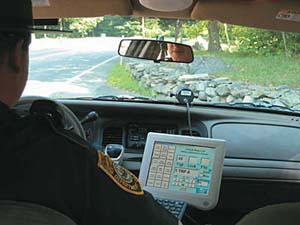 |
 |
| current issue |  |
past issues |  |
send a letter/news |  |
address update |  |
advertise |  |
about us |  |
alumni home |
Campus Currents
If These White Walls Could Talkby Elibet Moore Chase '81, '02G
 Courtesy of Kriste Krstovski |
If you put a group of engineers, a bunch of law enforcement officials and one U.S. senator in a room together, what do you get? No, not an innovative, FDA-approved way to eat a doughnut. You get a police car you can talk to.
Project 54 came out of discussions that started in 1996 between the New Hampshire Department of Safety and UNH engineers. Five years later, 160 police cruisers have been outfitted. Now that an additional $7.2 million--for a total of $21.8 million--has been secured with the assistance of Sen. Judd Gregg (R-N.H.) the project will be able to equip hundreds more. "We are installing our system in about 30 cars per month," says project lead engineer Bill Lenharth '74G, '78G, director of the UNH Research Computing Center. A total of 400 cars will be outfitted by the year's end, with an additional 110 scheduled for 2005.
The project's technology provides an integrated network of voice-activated commands. For example, an officer can start the siren, call home base on the radio and turn on a radar gun without taking eyes off the road or hands off the wheel. This summer, the data-integration component will be finished, providing officers with high-speed wireless data access via VHF radio data channels and network connections.
When State Police Sgt. Mark Liebl first heard of Project 54, he thought he was reading a script to a Buck Rogers movie. All he could say was, "Can you do it?" Four years later, Liebl is a convert. "They have more than proven themselves," he says. And when Liebl takes his car to industry shows, officers from all over the country clamor to learn more about the technology, which is happening only in New Hampshire. "Once the initial 'Wow' factor wears off," says Liebl, "they want to know how we did it."
They did it with a lot of collaboration, not only from engineers and law enforcement officials, but also nearly 30 students, both graduate and undergraduate, who have worked on the project. "Many students have used the work to provide material for their theses," says Lenharth. "And many undergraduates decide to stay on the project to complete their M.S. degrees." ~
Easy to print version
blog comments powered by Disqus

